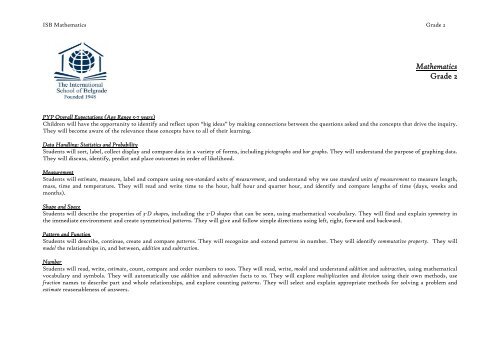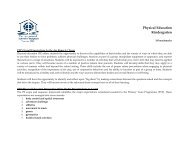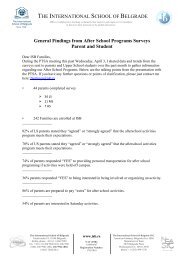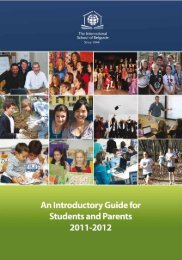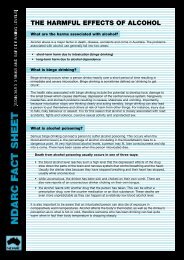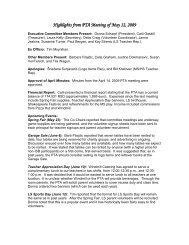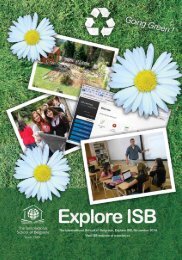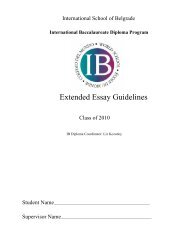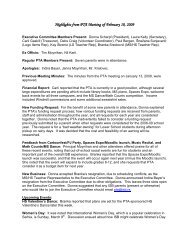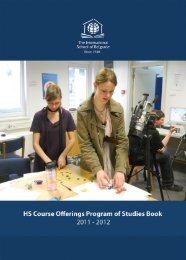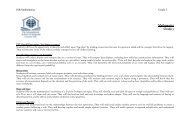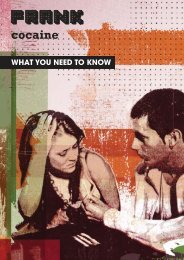Mathematics - Grade 2.pdf
Mathematics - Grade 2.pdf
Mathematics - Grade 2.pdf
Create successful ePaper yourself
Turn your PDF publications into a flip-book with our unique Google optimized e-Paper software.
ISB <strong>Mathematics</strong> <strong>Grade</strong> 2<br />
<strong>Mathematics</strong><br />
<strong>Grade</strong> 2<br />
PYP Overall Expectations (Age Range 5-7 years)<br />
Children will have the opportunity to identify and reflect upon “big ideas” by making connections between the questions asked and the concepts that drive the inquiry.<br />
They will become aware of the relevance these concepts have to all of their learning.<br />
Data Handling: Statistics and Probability<br />
Students will sort, label, collect display and compare data in a variety of forms, including pictographs and bar graphs. They will understand the purpose of graphing data.<br />
They will discuss, identify, predict and place outcomes in order of likelihood.<br />
Measurement<br />
Students will estimate, measure, label and compare using non-standard units of measurement, and understand why we use standard units of measurement to measure length,<br />
mass, time and temperature. They will read and write time to the hour, half hour and quarter hour, and identify and compare lengths of time (days, weeks and<br />
months).<br />
Shape and Space<br />
Students will describe the properties of 3-D shapes, including the 2-D shapes that can be seen, using mathematical vocabulary. They will find and explain symmetry in<br />
the immediate environment and create symmetrical patterns. They will give and follow simple directions using left, right, forward and backward.<br />
Pattern and Function<br />
Students will describe, continue, create and compare patterns. They will recognize and extend patterns in number. They will identify commutative property. They will<br />
model the relationships in, and between, addition and subtraction.<br />
Number<br />
Students will read, write, estimate, count, compare and order numbers to 1000. They will read, write, model and understand addition and subtraction, using mathematical<br />
vocabulary and symbols. They will automatically use addition and subtraction facts to 10. They will explore multiplication and division using their own methods, use<br />
fraction names to describe part and whole relationships, and explore counting patterns. They will select and explain appropriate methods for solving a problem and<br />
estimate reasonableness of answers.
ISB <strong>Mathematics</strong> <strong>Grade</strong> 2<br />
PYP<br />
Understands the meaning, uses, and representation of<br />
numbers<br />
Counts forward by 1s, 2s, 5s, 10s, 25s, and 100s to 1,000;<br />
counts backward by 1s from any number less than 1,000.<br />
Reads and writes whole numbers to 1,000 using standard<br />
base-10 place-value notation; identifies digits and<br />
expresses their values in such numbers; reads and writes<br />
numbers in dollars-and-cents notation.<br />
Uses concrete materials and drawings to represent and<br />
explain fractions as equal parts of a region or collection.<br />
Curriculum Examples/Ideas<br />
PYP Understands equivalent names and numbers Curriculum Examples/Ideas<br />
Uses tally marks and numerical expressions involving<br />
addition and subtraction of whole numbers to find<br />
equivalent names for numbers; uses concrete materials<br />
and pictures to find equivalent names for common<br />
fractions (e.g., halves, thirds, and fourths).<br />
PYP Understands common numerical relations Curriculum Examples/Ideas<br />
Orders whole numbers past 1,000; uses > and
ISB <strong>Mathematics</strong> <strong>Grade</strong> 2<br />
PYP Computes accurately Curriculum Examples/Ideas<br />
Knows and applies addition and subtraction facts through<br />
10 + 10.<br />
Uses and explains strategies (e.g., base-10 blocks, number<br />
grid, tally marks, mental arithmetic, paper-and-pencil<br />
algorithm) for solving problems and number stories<br />
involving the addition and subtraction of 2-digit and 2-<br />
digit whole numbers.<br />
PYP Makes reasonable estimates Curriculum Examples/Ideas<br />
Uses strategies to estimate reasonable solutions (ballpark<br />
estimates) for whole number addition and subtraction<br />
problems.<br />
PYP<br />
Understands meanings of operations and how they<br />
relate to one another<br />
Demonstrates, describes, and applies change-to-more,<br />
change-to-less, comparison, and parts-and-total situations;<br />
uses repeated addition, arrays, and continuing by<br />
multiples to do multiplication.<br />
Curriculum Examples/Ideas
ISB <strong>Mathematics</strong> <strong>Grade</strong> 2<br />
PYP Understands patterns, relations, and functions Curriculum Examples/Ideas<br />
Continues simple numerical and non-numerical patterns;<br />
finds rules for patterns and uses them to solve problems.<br />
Finds rules for simple functions involving addition and<br />
subtraction; uses those rules or other strategies to solve<br />
problems.<br />
PYP<br />
Represents and analyzes situations and structures<br />
using algebraic symbols<br />
Uses and explains the symbols +, -, =, >, and
ISB <strong>Mathematics</strong> <strong>Grade</strong> 2<br />
PYP<br />
Understands the units, systems, and processes of<br />
measurement; uses appropriate techniques, tools, and<br />
formulas to determine measurement<br />
Estimates and compares the length of and measure objects<br />
to the nearest inch and centimeter.<br />
Counts unit squares to find the area of rectangular shapes.<br />
Describes the relationships between units of time (e.g.,<br />
days in a week and hours in a day.)<br />
Calculates and compares values of coin and bill<br />
combinations.<br />
Curriculum Examples/Ideas<br />
PYP Uses reference frames to locate numbers within a<br />
given context<br />
Curriculum Examples/Ideas<br />
Reads temperature to the nearest degree on both the<br />
Fahrenheit and Celsius scales.<br />
Shows and tells time on an analog and digital clock to the<br />
nearest five minutes; writes time in digital notation.
ISB <strong>Mathematics</strong> <strong>Grade</strong> 2<br />
PYP<br />
Analyzes characteristics and properties of two- and<br />
three-dimensional geometric shapes<br />
Drawl line segments and identifies parallel line segments.<br />
Identifies, describes, and models plane and solid figures<br />
including circles, triangles, squares, rectangles, hexagons,<br />
trapezoids, rhombuses, spheres, cylinders, rectangular<br />
prisms, pyramids, cones, and cubes.<br />
Curriculum Examples/Ideas<br />
PYP<br />
Applies transformations and uses symmetry to<br />
analyze mathematical situations<br />
Creates and completes simple two-dimensional symmetric<br />
shapes or designs.<br />
Curriculum Examples/Ideas<br />
PYP<br />
Selects, creates, and uses appropriate graphical<br />
representations of collected or given data<br />
Creates and uses tally charts, bar graphs, and line plots.<br />
Curriculum Examples/Ideas
ISB <strong>Mathematics</strong> <strong>Grade</strong> 2<br />
PYP Analyzes and interprets data Curriculum Examples/Ideas<br />
Asks and answers questions and draws conclusions based<br />
on data representations; finds the maximum, minimum,<br />
of a grade-appropriate data set.<br />
PYP<br />
Understands and applies basic concepts of probability Curriculum Examples/Ideas<br />
Explains and uses the most basic language of probability<br />
(e.g., certain, likely, unlikely, impossible) to describe<br />
single events.


